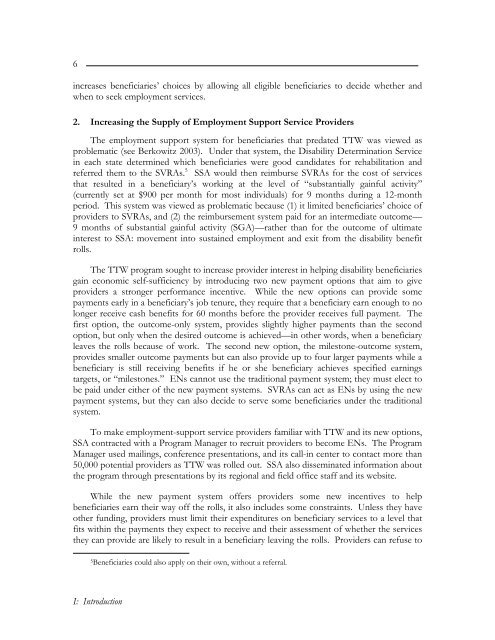Evaluation of the Ticket To Work Program - Mathematica Policy ...
Evaluation of the Ticket To Work Program - Mathematica Policy ...
Evaluation of the Ticket To Work Program - Mathematica Policy ...
Create successful ePaper yourself
Turn your PDF publications into a flip-book with our unique Google optimized e-Paper software.
6<br />
increases beneficiaries’ choices by allowing all eligible beneficiaries to decide whe<strong>the</strong>r and<br />
when to seek employment services.<br />
2. Increasing <strong>the</strong> Supply <strong>of</strong> Employment Support Service Providers<br />
The employment support system for beneficiaries that predated TTW was viewed as<br />
problematic (see Berkowitz 2003). Under that system, <strong>the</strong> Disability Determination Service<br />
in each state determined which beneficiaries were good candidates for rehabilitation and<br />
referred <strong>the</strong>m to <strong>the</strong> SVRAs. 5 SSA would <strong>the</strong>n reimburse SVRAs for <strong>the</strong> cost <strong>of</strong> services<br />
that resulted in a beneficiary’s working at <strong>the</strong> level <strong>of</strong> “substantially gainful activity”<br />
(currently set at $900 per month for most individuals) for 9 months during a 12-month<br />
period. This system was viewed as problematic because (1) it limited beneficiaries’ choice <strong>of</strong><br />
providers to SVRAs, and (2) <strong>the</strong> reimbursement system paid for an intermediate outcome—<br />
9 months <strong>of</strong> substantial gainful activity (SGA)—ra<strong>the</strong>r than for <strong>the</strong> outcome <strong>of</strong> ultimate<br />
interest to SSA: movement into sustained employment and exit from <strong>the</strong> disability benefit<br />
rolls.<br />
The TTW program sought to increase provider interest in helping disability beneficiaries<br />
gain economic self-sufficiency by introducing two new payment options that aim to give<br />
providers a stronger performance incentive. While <strong>the</strong> new options can provide some<br />
payments early in a beneficiary’s job tenure, <strong>the</strong>y require that a beneficiary earn enough to no<br />
longer receive cash benefits for 60 months before <strong>the</strong> provider receives full payment. The<br />
first option, <strong>the</strong> outcome-only system, provides slightly higher payments than <strong>the</strong> second<br />
option, but only when <strong>the</strong> desired outcome is achieved—in o<strong>the</strong>r words, when a beneficiary<br />
leaves <strong>the</strong> rolls because <strong>of</strong> work. The second new option, <strong>the</strong> milestone-outcome system,<br />
provides smaller outcome payments but can also provide up to four larger payments while a<br />
beneficiary is still receiving benefits if he or she beneficiary achieves specified earnings<br />
targets, or “milestones.” ENs cannot use <strong>the</strong> traditional payment system; <strong>the</strong>y must elect to<br />
be paid under ei<strong>the</strong>r <strong>of</strong> <strong>the</strong> new payment systems. SVRAs can act as ENs by using <strong>the</strong> new<br />
payment systems, but <strong>the</strong>y can also decide to serve some beneficiaries under <strong>the</strong> traditional<br />
system.<br />
<strong>To</strong> make employment-support service providers familiar with TTW and its new options,<br />
SSA contracted with a <strong>Program</strong> Manager to recruit providers to become ENs. The <strong>Program</strong><br />
Manager used mailings, conference presentations, and its call-in center to contact more than<br />
50,000 potential providers as TTW was rolled out. SSA also disseminated information about<br />
<strong>the</strong> program through presentations by its regional and field <strong>of</strong>fice staff and its website.<br />
While <strong>the</strong> new payment system <strong>of</strong>fers providers some new incentives to help<br />
beneficiaries earn <strong>the</strong>ir way <strong>of</strong>f <strong>the</strong> rolls, it also includes some constraints. Unless <strong>the</strong>y have<br />
o<strong>the</strong>r funding, providers must limit <strong>the</strong>ir expenditures on beneficiary services to a level that<br />
fits within <strong>the</strong> payments <strong>the</strong>y expect to receive and <strong>the</strong>ir assessment <strong>of</strong> whe<strong>the</strong>r <strong>the</strong> services<br />
<strong>the</strong>y can provide are likely to result in a beneficiary leaving <strong>the</strong> rolls. Providers can refuse to<br />
5 Beneficiaries could also apply on <strong>the</strong>ir own, without a referral.<br />
I: Introduction
















